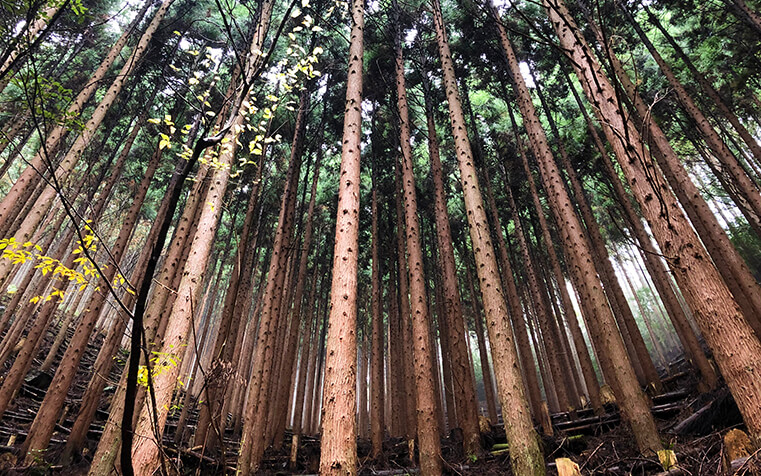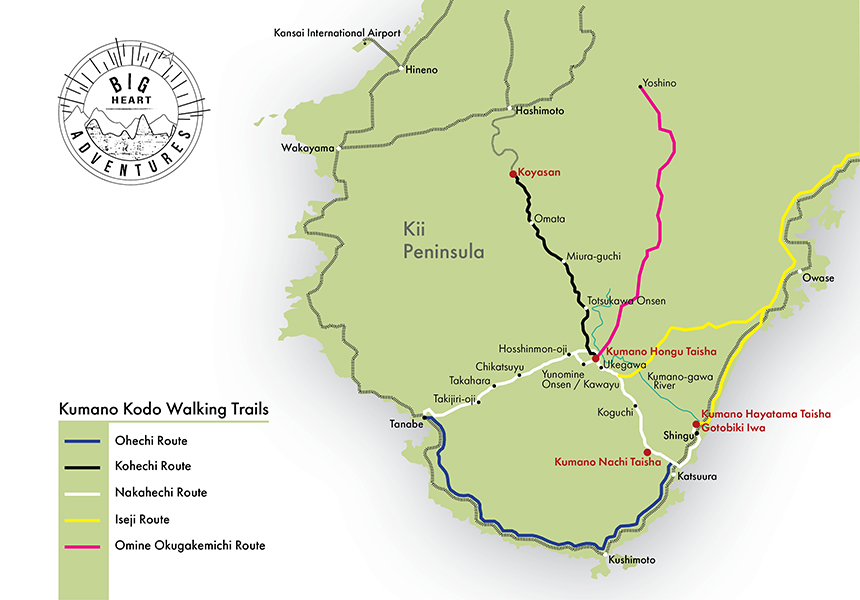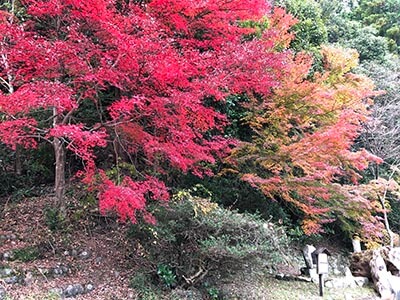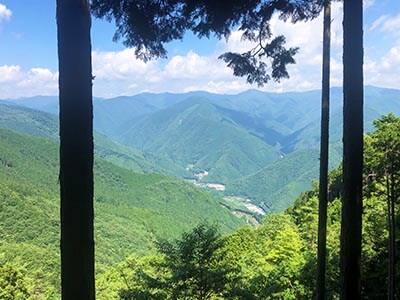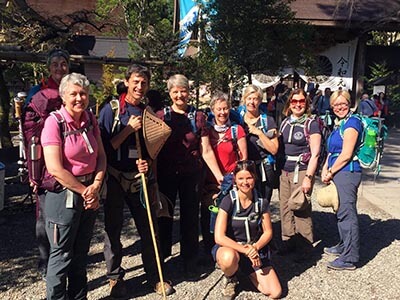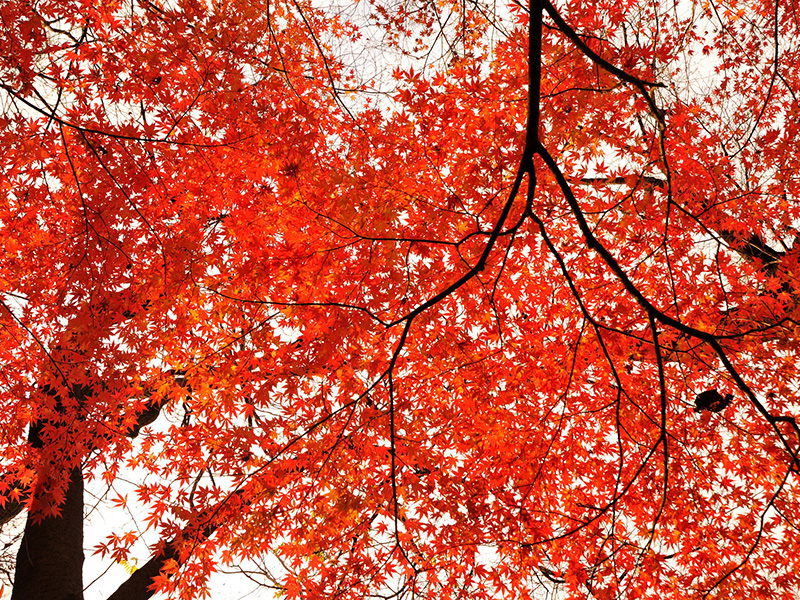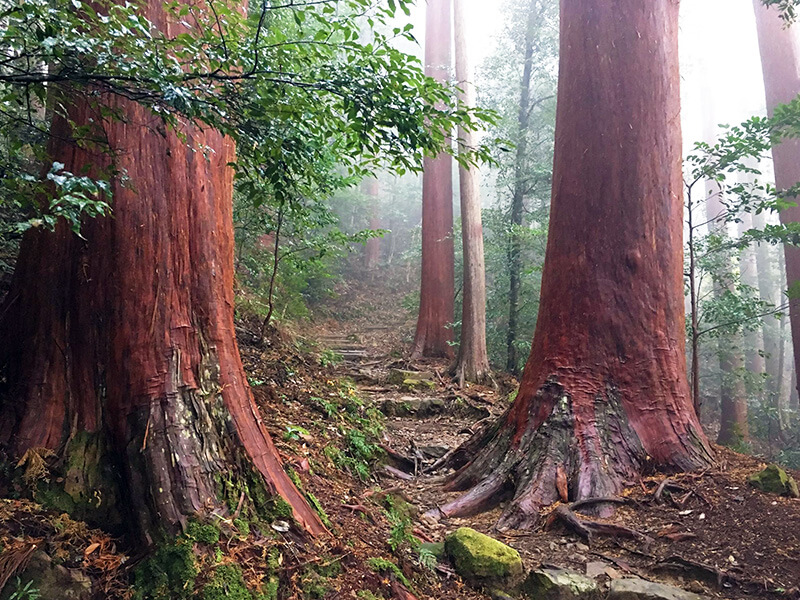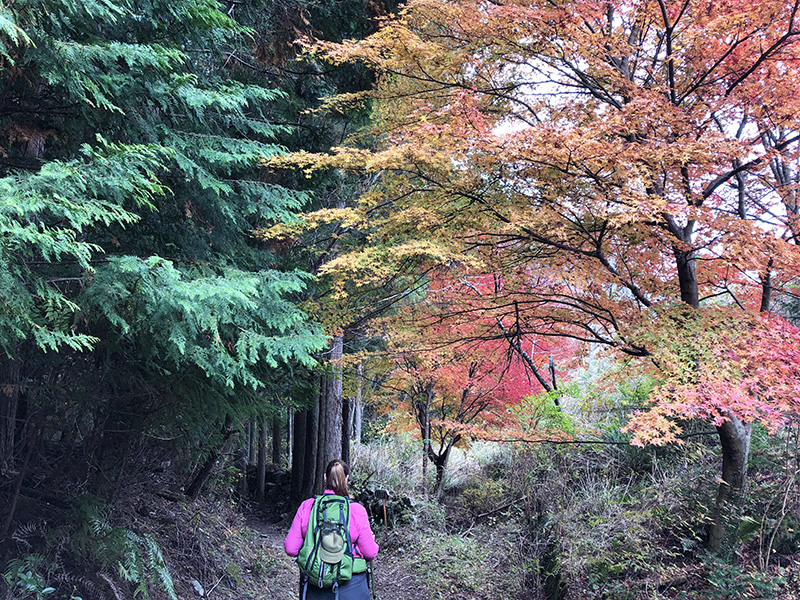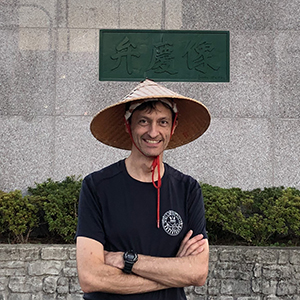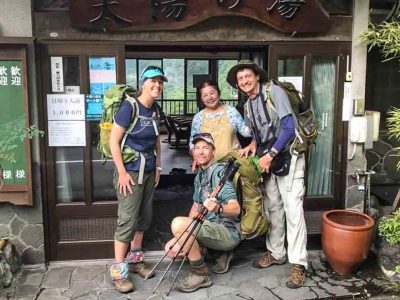Author: Ian Murphy
Walking the Kumano Kodo pilgrimage trail in Japan is on the bucket list of most multi-day hikers. But which of the five routes is best? Chances are, you may only get to experience one Kumano Kodo in your lifetime, so which one to walk?
Firstly, let’s look at the options and then we’ll briefly delve into what each offer to help you make an informed decision.
There are 5 recognised trails traversing to one of the grand shrines of the Kumano Kodo, and all have UNESCO world heritage status for all or some sections. They’re named Iseji, Kohechi, Nakahechi, Ohechi, and Omine Okugake Michi.
Iseji (Eastern Route)
From the Ise Jingu, this route follows the eastern coastline to Kumano Hayatama Taisha, or branches off towards Kumano Hongu Taisha. The total distance is approximately 170km / 105 miles.
Kohechi (Mountainous Route)
This route starts in Koyasan and traverse’s mountain passes south to Kumano Hongu Taisha. These mountain passes reach to around 1200m in altitude. The total distance is approximately 75km / 46 miles.
Nakahechi (Imperial Route)
This is the most popular route and has the most infrastructure and services in place. The total distance is approximately 130km / 80 miles. Excluding the road sections between Tanabe to Takijiri-oji, and Hongu to Kumano Hayatama Taisha shortens the distance to approximately 85km / 53 miles.
Ohechi (Coastal Route)
Starting from Tanabe this route runs parallel to the southern coast finishing at Fudarakusan-ji Temple near Nachi train station. A bus or walk along the Nakahechi trail is required to reach one of the Grand Shrines. The total distance is approximately 120km / 75 miles.
Omine Okugakemichi (Shugendo Practitioners Route)
Without doubt this is the hardest route. Starting from Yoshino and finishing at Kumano Hongu Taisha, with mountain passes up to 1900m in altitude. The total distance is approximately 95km / 60 miles.
So which Kumano Kodo route is best?
Basically, this is a personal choice after considering a few things:
- When do you want to go?
- How many days do you want to walk?
- How well do you understand Japanese?
- What’s your level of fitness?
- What’s your past hiking experience?
- Are you good at navigating?
- Do you want to avoid the crowds?
- What’s your level of interest in history, flora and fauna?
- What’s your level of interest in Japanese culture and food?
- How much weight in your pack do you want to carry?
- What style of accommodation are you wanting?
- How difficult do you want the walk to be?
- Your health and safety while walking.
- Collecting pilgrimage passport stamps (only Kohechi and Nakahechi routes have these)
To answer some of these questions we provide the following information. This information is for quick reference only and is intended as a general guide. Furthermore, you must do your own research as part of your preparations to determine the limits of accuracy of this information before walking the Kumano Kodo. Up to date information can be obtained by contacting the Tanabe Tourism Bureau.
What’s the best time of year to walk the Kumano Kodo?
Which route you choose will also depend on what month you plan to travel to Japan’s Kii Peninsula. Although the weather is always unpredictable, generally:
Springtime, March and April is a very popular and more expensive time to visit. Tourists are drawn to the cherry tree blossoms. These months are great to walk the Kumano Kodo, however snow may still be present on the higher peaks of the Omine Okugakemichi and Kohechi routes.
Summertime, June and July is less busy because of higher temperatures, heavier rainfall and increased humidity.
During Autumn/Fall, October and November deciduous trees light the trail in shades of red and yellow. This is also a comfortable time to walk the Kumano Kodo routes, however snow may start falling on the higher peaks of the Omine Okugakemichi and Kohechi routes in November.
Wintertime, December, January and February brings cold days and snow to the peaks. Some sections may be impassable at this time. The daylight hours are also less so the distance you can cover in a full day will be reduced.
The month of May might miss the time of trees blossoming but will be drier along the trails.
During August and September, the Kii Peninsula is more likely to be hit by typhoons and the walking trails will close during these events.
Are you best joining a guided tour?
Booking a guided tour is always recommended if you want to deepen your Kumano Kodo experience. This is because the Kumano Kodo is bursting with culture and history, and greater you’re understanding the more meaningful it will be. No number of guidebooks or maps can bring the trail to life as well as a local guide. This is especially true if you have a limited grasp of the Japanese language.
Reputable tour operators will also use experienced guides to lead their Kumano Kodo tours. These guides should have the skills to deal with incidents if they occur. Meaning your safety is considered.
However, public guided tours do not operate on the Iseji, Ohechi or Omine Okugakemichi routes. This is mainly because of low demand due to limited infrastructure and resources, or the trails remoteness and difficulty.
There’s one tour operator that currently offers end to end small group guided tours on the Kohechi route. This tour includes a local guide. Read more about this tour.
The Nakahechi route is promoted and offered by a lot of tour operators. Some use local guides and others use guides from their home countries. These tours vary in duration and may include different sections of the Nakahechi Route, so it’s best to choose the one that fits your needs.
Going unguided is more affordable for a lot of people planning to walk the Kumano Kodo. This is a good option too if you have a good grasp of the Japanese language and have confidence walking on trails. If going self-guided, you should never just rely on an electrical device such as your smartphone for navigation. Make sure you carry printed maps and have basic navigation skills. Walking unguided on the Kohechi and Omine Okugakemichi routes should only be attempted if you’re an experienced hiker, due to their remoteness, lack of signage, technical terrain and exposer to sudden and potentially dangerous changes in the weather. Walkers do get lost and there are deaths that occur on these trails, so they must not be underestimated.
Avoiding the crowds on the Kumano Kodo
The popularity of the Kumano Kodo is growing. There’s an ever-increasing number of walkers annually and by far the majority walk the Nakahechi route to Hongu. To avoid these crowds, it’s recommended to walk in the off-season or choose a different route.
The Iseji and Ohechi routes have lovely quiet sections to walk. However, you must be prepared to walk long distances on busy hard-surfaced roads for days if you want to walk these routes end-to-end. An option might be to walk the quieter sections as shorter day walks and skip the rest…not good if you’re a completionist though.
The Kohechi and Omine Okugakemichi are a lot quieter than the Nakahechi and are perfect if you want to walk a route end-to-end without the crowds. Generally, the Kohechi takes 4 days and the Omine Okugakemichi takes 7 days to complete.
Why you should consider the Iseji route
- Starts from the famous Ise shrine in Mie Prefecture
- You’re confident in navigating without the need of signage
- Varying landscapes from farms, villages, mountains and coast
- You’ve plenty of time, approximately 10 days are needed to walk this route
- Trail is rated MODERATE (option to walk with a day pack and have main luggage transferred along the trail)
Why you should consider the Kohechi route
- Start and finish in 2 of Japan’s most sacred places (Koyasan and Hongu) and pass through some of Japan’s most beautiful villages
- You hate crowds, you’re likely to not see anyone else along the trail
- Options for comfortable accommodation and meals supplied each night
- You’ve already walked Nakahechi and want the same traditional feeling but a different trail
- Trail is rated HARD (option to walk with a day pack and have main luggage transferred along the trail)
Why you should consider the Nakahechi route
- Lots of options for accommodation and more English-speaking hosts
- A local bus service operates along the trail so you can skip sections
- Trail is well marked so easier to navigate if you’re inexperienced
- More people so more help is available if you get into trouble
- Trail is rated MODERATE (option to walk with a day pack and have main luggage transferred along the trail)
Why you should consider the Ohechi route
- Experience the pilgrimage route that ordinary people followed during the Edo period
- You’re confident in navigating without the need of signage
- Spectacular views of the coastline
- You don’t mind walking adjacent busy roads
- Trail is rated MODERATE (option to walk with a day pack and have main luggage transferred along the trail)
Why you should consider the Omine Okugakemichi route
- You’re an experienced self-sufficient hiker
- You hate crowds, you’re likely to not see anyone else along the trail
- Less paved roads
- Spectacular mountain passes (please note: women are prohibited from walking the Mt Omine section of this trail)
- Trail is rated HARD (must carry a full pack as no luggage transfers available)
In summary, no matter which of the routes you choose, you are bound to gain wonderful memories and a greater understanding of traditional Japan by walking the Kumano Kodo.
Thank you for reading. Hopefully this little blog has got you thinking and will help you plan your best Kumano Kodo experience. If you are interested in joining us, we have links to our Kumano Kodo itineraries below.
Why walk the Kumano Kodo with Big Heart Adventures
- Flexibility (2 guides)
each group departure has 2 experienced guides. Therefore, your holiday isn’t interrupted if someone in the group has an incident, and we can better cater for group dynamics and needs - Safety
our wilderness first-aid trained guide from Australia and our experienced bilingual local guide are on every departure. Comprehensive first-aid kits are carried by guides, procedures are in place, and constant communication is undertaken with local emergency services - Nature Connection
invitations for you to connect deeper with nature on the trail. You will experience facilitated nature connection sessions such as forest bathing throughout your walk - Timing
we go at the best time of the year to capture autumn colour and to experience local festivals and events. We can’t guarantee perfect weather everyday, but you can book with confidence - Group Fitness
a Kumano Kodo training program and guided training walks are provided leading up to your departure. These will help you prepare for your trip. Preparing yourself properly is they key to maximising your enjoyment and the groups enjoyment when away. We also provide pre-departure group chats via Zoom. These will assist you to practice on terrain that you are likely to encounter, meet other group members, ask questions on what to expect, receive advice on the trail, travel, and the destination, and gage your level of fitness compared to other group members. - Meaningful moments
learn about spiritual history and traditional Japan. Our local bilingual guide will bring your Kumano Kodo experience alive - Value for Money
all departures are more than just a trek. We help you and other group members reach a required fitness level. As you walk we teach you about the history of the trail, translate and share stories at the ancient sites, and provide opportunities for you to connect deeply with nature and your surrounds. We pack a lot in to the itineraries so you get the full experience, but still provide the time to relax - Small groups
a maximum of 10 only on each departure. Meaning, it’s better for the environment and you won’t feel like you’re just a number in the crowd - No getting lost
our experienced guides know the trail well and where your accommodation will be each night. You don’t need to worry about walking around in circles trying to ask for directions at the end of a big day - Private/Personalised trips
we can also plan and book Kumano Kodo itineraries the way you want it, either guided or self-guided - Travel in Japan
maximise your time and see more of Japan. Our in-house travel specialists can assist you with rail passes, accommodation, flights, add-ons and insurance. Package your Kumano Kodo walk with us and save stress, time and money
Additional Reading
Big Heart Adventures is a commercial tour operator (CTO) and lead walking adventures along the Kumano Kodo Pilgrimage Routes in Japan.
We also offer many more walking adventures throughout South Australia, Australia and abroad. Choose between fully guided walking tours and self-guided walking adventures.
Read more about ‘Big Heart Adventures’ and our commitment to accessibility.

